Lingjie Liu
Zero-shot Reconstruction of In-Scene Object Manipulation from Video
Dec 22, 2025Abstract:We build the first system to address the problem of reconstructing in-scene object manipulation from a monocular RGB video. It is challenging due to ill-posed scene reconstruction, ambiguous hand-object depth, and the need for physically plausible interactions. Existing methods operate in hand centric coordinates and ignore the scene, hindering metric accuracy and practical use. In our method, we first use data-driven foundation models to initialize the core components, including the object mesh and poses, the scene point cloud, and the hand poses. We then apply a two-stage optimization that recovers a complete hand-object motion from grasping to interaction, which remains consistent with the scene information observed in the input video.
DIMO: Diverse 3D Motion Generation for Arbitrary Objects
Nov 10, 2025
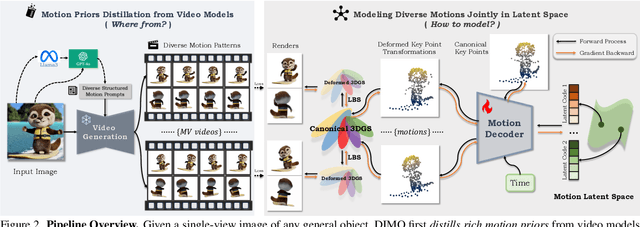
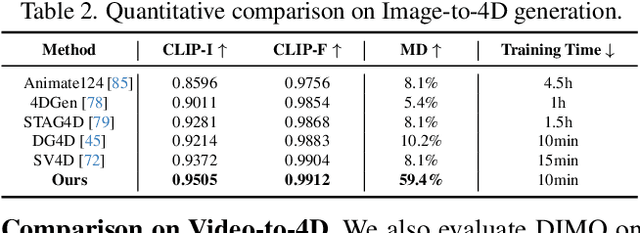
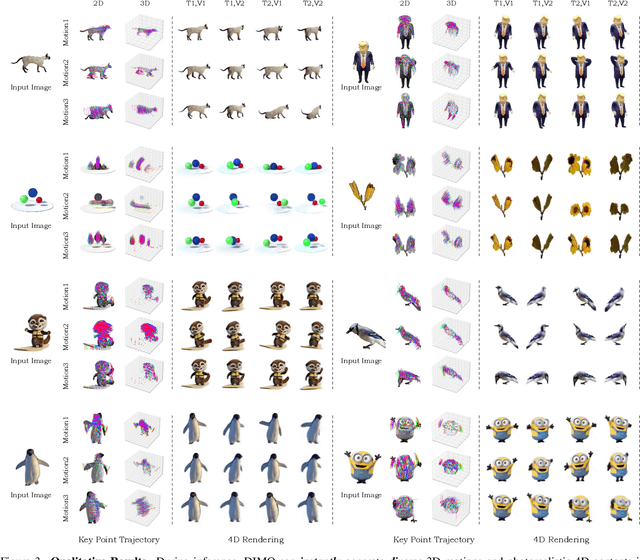
Abstract:We present DIMO, a generative approach capable of generating diverse 3D motions for arbitrary objects from a single image. The core idea of our work is to leverage the rich priors in well-trained video models to extract the common motion patterns and then embed them into a shared low-dimensional latent space. Specifically, we first generate multiple videos of the same object with diverse motions. We then embed each motion into a latent vector and train a shared motion decoder to learn the distribution of motions represented by a structured and compact motion representation, i.e., neural key point trajectories. The canonical 3D Gaussians are then driven by these key points and fused to model the geometry and appearance. During inference time with learned latent space, we can instantly sample diverse 3D motions in a single-forward pass and support several interesting applications including 3D motion interpolation and language-guided motion generation. Our project page is available at https://linzhanm.github.io/dimo.
FormCoach: Lift Smarter, Not Harder
Aug 10, 2025Abstract:Good form is the difference between strength and strain, yet for the fast-growing community of at-home fitness enthusiasts, expert feedback is often out of reach. FormCoach transforms a simple camera into an always-on, interactive AI training partner, capable of spotting subtle form errors and delivering tailored corrections in real time, leveraging vision-language models (VLMs). We showcase this capability through a web interface and benchmark state-of-the-art VLMs on a dataset of 1,700 expert-annotated user-reference video pairs spanning 22 strength and mobility exercises. To accelerate research in AI-driven coaching, we release both the dataset and an automated, rubric-based evaluation pipeline, enabling standardized comparison across models. Our benchmarks reveal substantial gaps compared to human-level coaching, underscoring both the challenges and opportunities in integrating nuanced, context-aware movement analysis into interactive AI systems. By framing form correction as a collaborative and creative process between humans and machines, FormCoach opens a new frontier in embodied AI.
StereoDiff: Stereo-Diffusion Synergy for Video Depth Estimation
Jun 25, 2025



Abstract:Recent video depth estimation methods achieve great performance by following the paradigm of image depth estimation, i.e., typically fine-tuning pre-trained video diffusion models with massive data. However, we argue that video depth estimation is not a naive extension of image depth estimation. The temporal consistency requirements for dynamic and static regions in videos are fundamentally different. Consistent video depth in static regions, typically backgrounds, can be more effectively achieved via stereo matching across all frames, which provides much stronger global 3D cues. While the consistency for dynamic regions still should be learned from large-scale video depth data to ensure smooth transitions, due to the violation of triangulation constraints. Based on these insights, we introduce StereoDiff, a two-stage video depth estimator that synergizes stereo matching for mainly the static areas with video depth diffusion for maintaining consistent depth transitions in dynamic areas. We mathematically demonstrate how stereo matching and video depth diffusion offer complementary strengths through frequency domain analysis, highlighting the effectiveness of their synergy in capturing the advantages of both. Experimental results on zero-shot, real-world, dynamic video depth benchmarks, both indoor and outdoor, demonstrate StereoDiff's SoTA performance, showcasing its superior consistency and accuracy in video depth estimation.
Vid2Sim: Generalizable, Video-based Reconstruction of Appearance, Geometry and Physics for Mesh-free Simulation
Jun 06, 2025

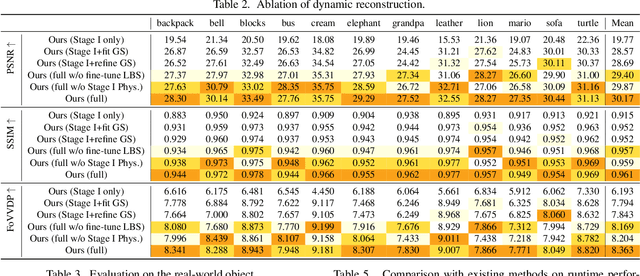

Abstract:Faithfully reconstructing textured shapes and physical properties from videos presents an intriguing yet challenging problem. Significant efforts have been dedicated to advancing such a system identification problem in this area. Previous methods often rely on heavy optimization pipelines with a differentiable simulator and renderer to estimate physical parameters. However, these approaches frequently necessitate extensive hyperparameter tuning for each scene and involve a costly optimization process, which limits both their practicality and generalizability. In this work, we propose a novel framework, Vid2Sim, a generalizable video-based approach for recovering geometry and physical properties through a mesh-free reduced simulation based on Linear Blend Skinning (LBS), offering high computational efficiency and versatile representation capability. Specifically, Vid2Sim first reconstructs the observed configuration of the physical system from video using a feed-forward neural network trained to capture physical world knowledge. A lightweight optimization pipeline then refines the estimated appearance, geometry, and physical properties to closely align with video observations within just a few minutes. Additionally, after the reconstruction, Vid2Sim enables high-quality, mesh-free simulation with high efficiency. Extensive experiments demonstrate that our method achieves superior accuracy and efficiency in reconstructing geometry and physical properties from video data.
Ego4o: Egocentric Human Motion Capture and Understanding from Multi-Modal Input
Apr 11, 2025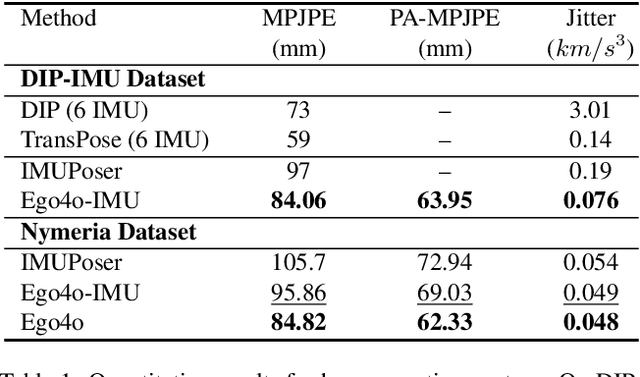
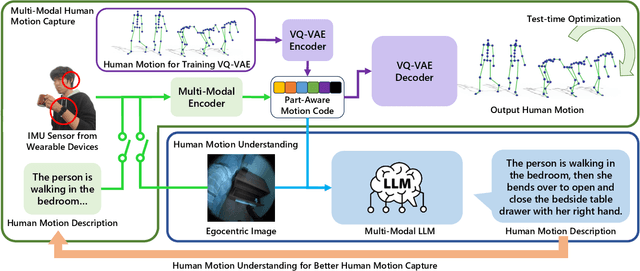

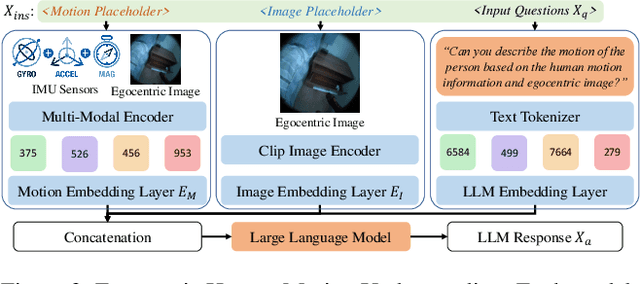
Abstract:This work focuses on tracking and understanding human motion using consumer wearable devices, such as VR/AR headsets, smart glasses, cellphones, and smartwatches. These devices provide diverse, multi-modal sensor inputs, including egocentric images, and 1-3 sparse IMU sensors in varied combinations. Motion descriptions can also accompany these signals. The diverse input modalities and their intermittent availability pose challenges for consistent motion capture and understanding. In this work, we present Ego4o (o for omni), a new framework for simultaneous human motion capture and understanding from multi-modal egocentric inputs. This method maintains performance with partial inputs while achieving better results when multiple modalities are combined. First, the IMU sensor inputs, the optional egocentric image, and text description of human motion are encoded into the latent space of a motion VQ-VAE. Next, the latent vectors are sent to the VQ-VAE decoder and optimized to track human motion. When motion descriptions are unavailable, the latent vectors can be input into a multi-modal LLM to generate human motion descriptions, which can further enhance motion capture accuracy. Quantitative and qualitative evaluations demonstrate the effectiveness of our method in predicting accurate human motion and high-quality motion descriptions.
CBIL: Collective Behavior Imitation Learning for Fish from Real Videos
Mar 31, 2025
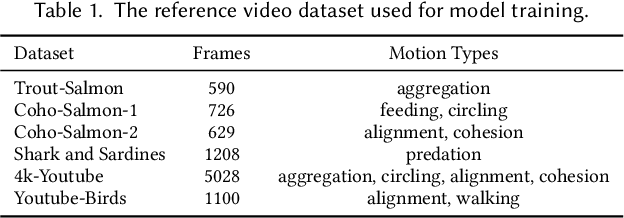
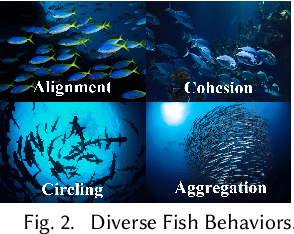

Abstract:Reproducing realistic collective behaviors presents a captivating yet formidable challenge. Traditional rule-based methods rely on hand-crafted principles, limiting motion diversity and realism in generated collective behaviors. Recent imitation learning methods learn from data but often require ground truth motion trajectories and struggle with authenticity, especially in high-density groups with erratic movements. In this paper, we present a scalable approach, Collective Behavior Imitation Learning (CBIL), for learning fish schooling behavior directly from videos, without relying on captured motion trajectories. Our method first leverages Video Representation Learning, where a Masked Video AutoEncoder (MVAE) extracts implicit states from video inputs in a self-supervised manner. The MVAE effectively maps 2D observations to implicit states that are compact and expressive for following the imitation learning stage. Then, we propose a novel adversarial imitation learning method to effectively capture complex movements of the schools of fish, allowing for efficient imitation of the distribution for motion patterns measured in the latent space. It also incorporates bio-inspired rewards alongside priors to regularize and stabilize training. Once trained, CBIL can be used for various animation tasks with the learned collective motion priors. We further show its effectiveness across different species. Finally, we demonstrate the application of our system in detecting abnormal fish behavior from in-the-wild videos.
ModSkill: Physical Character Skill Modularization
Feb 19, 2025Abstract:Human motion is highly diverse and dynamic, posing challenges for imitation learning algorithms that aim to generalize motor skills for controlling simulated characters. Previous methods typically rely on a universal full-body controller for tracking reference motion (tracking-based model) or a unified full-body skill embedding space (skill embedding). However, these approaches often struggle to generalize and scale to larger motion datasets. In this work, we introduce a novel skill learning framework, ModSkill, that decouples complex full-body skills into compositional, modular skills for independent body parts. Our framework features a skill modularization attention layer that processes policy observations into modular skill embeddings that guide low-level controllers for each body part. We also propose an Active Skill Learning approach with Generative Adaptive Sampling, using large motion generation models to adaptively enhance policy learning in challenging tracking scenarios. Our results show that this modularized skill learning framework, enhanced by generative sampling, outperforms existing methods in precise full-body motion tracking and enables reusable skill embeddings for diverse goal-driven tasks.
Zero-1-to-G: Taming Pretrained 2D Diffusion Model for Direct 3D Generation
Jan 09, 2025



Abstract:Recent advances in 2D image generation have achieved remarkable quality,largely driven by the capacity of diffusion models and the availability of large-scale datasets. However, direct 3D generation is still constrained by the scarcity and lower fidelity of 3D datasets. In this paper, we introduce Zero-1-to-G, a novel approach that addresses this problem by enabling direct single-view generation on Gaussian splats using pretrained 2D diffusion models. Our key insight is that Gaussian splats, a 3D representation, can be decomposed into multi-view images encoding different attributes. This reframes the challenging task of direct 3D generation within a 2D diffusion framework, allowing us to leverage the rich priors of pretrained 2D diffusion models. To incorporate 3D awareness, we introduce cross-view and cross-attribute attention layers, which capture complex correlations and enforce 3D consistency across generated splats. This makes Zero-1-to-G the first direct image-to-3D generative model to effectively utilize pretrained 2D diffusion priors, enabling efficient training and improved generalization to unseen objects. Extensive experiments on both synthetic and in-the-wild datasets demonstrate superior performance in 3D object generation, offering a new approach to high-quality 3D generation.
ProTracker: Probabilistic Integration for Robust and Accurate Point Tracking
Jan 06, 2025Abstract:In this paper, we propose ProTracker, a novel framework for robust and accurate long-term dense tracking of arbitrary points in videos. The key idea of our method is incorporating probabilistic integration to refine multiple predictions from both optical flow and semantic features for robust short-term and long-term tracking. Specifically, we integrate optical flow estimations in a probabilistic manner, producing smooth and accurate trajectories by maximizing the likelihood of each prediction. To effectively re-localize challenging points that disappear and reappear due to occlusion, we further incorporate long-term feature correspondence into our flow predictions for continuous trajectory generation. Extensive experiments show that ProTracker achieves the state-of-the-art performance among unsupervised and self-supervised approaches, and even outperforms supervised methods on several benchmarks. Our code and model will be publicly available upon publication.
 Add to Chrome
Add to Chrome Add to Firefox
Add to Firefox Add to Edge
Add to Edge